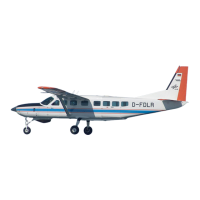SERVICE KIT
SK 208-179B
C. Apply sealant to a ll of the acces s plates and panels o n the bottoms of the wings, horizont al
stabilizer, and v e r tical stabiliz er, wit h U544055S Sealant and p etrol atum parting agent. (Refer to
the 208 Maintenance Manual, Chapter 6, Access Plates and P anels Identification - D es c r iption and
Opera tion, and Chapt er 20, Fuel, Weather, and High-Tem perat ure Seali ng - Maintenance Prac tice s.)
D. Inst all all of the w ing inspection panels and acces s plates that you removed from the w ings,
horizontal stabil izer, and vertical stabilizer. (Refer to the 208 Maintenance Manual, Chapter 6,
Access Plates and Pa nels Identification - Description and Operation.)
32. Remov e mai ntenance warning ta gs and connect the airplane battery.
33. Mak e sure that the airplane is level. (Refer to the Model 208 Maintenance Manual, Chapter 8, Lev eling -
Maintenance P rac tices.)
34. Weigh the airplane and c alculate a final weight and balanc e. (Ref er to t he c urrent applicable Pilots
Opera ting Handbo ok and the Model 208 Ma intenanc e Manual Chapter 8, Lev eling and Weighing.)
35. Do the TKS an ti-ice equipm ent p r eflight che ck that follows :
A. To make s ure of the cond ition and the security of all the com ponents of the TK S system , do the
PREFLIGHT INSPECTION checkli st from the Known Icin g Equipm ent Supplement.
WARNING: Do not run the TKS ice protection system in dry, c old air. Th e ice protection fluid
is designed to mix w ith water that impinges on the surface o f t he airplane during
normal operation. If you run the syst em during dry, cold air conditions, the fluid
bec omes a gel t hat takes much time to c lear, particularly f rom t he windshield.
B. With the airplane level and the TKS tank filled where the fluid level ball is just above the minimum
dispatch quantity line, do a che ck for the ac curacy of the flu id quantity indication.
C. Remove the air plane from jack s . (Refer to the Model 208 Maintenance Manual, Chapter 8, Leveli ng
- Maintenance Prac t ices .)
D. Turn the BACKUP switch to O N.
NOTE: During t he initial operation of the TKS system , the low pressure WA RN annunciator may
initially come ON and then should go out a s th e system begin s to flow and to build pressure.
E. Walk arou nd the airplane and make sure that there is a fluid flow to each porous panel that goes
the full length of the panel.
NOTE: At fluid temperatures that are abov e 59 °F (15 °C), flui d viscosity is s uc h that the operating
pressure may not cancel the low pressure WARN annunc iator. A t thes e fluid tem peratures,
you must make sure visually of the fu ll-length fl uid flow to each porous panel to make sure of
correct ope ration of t he system. Af te r initial operat ion, the low pressure WARN annunciator
should not come ON during in-flight system operation with the outside air temperature
(OAT) below 46 °F (8 °C).
36. Touch-up paint as necessary. ( Refe r to the Model 208 Maintenance Manual, Chapter 20, Exte rior
Finish - Clea ning/ Painting.)
37. Mak e an entry in the airplane logbook stating this se rvice kit has been installed.
38. After the accom plishm ent of this Servic e Kit y ou must do C orros ion Prevention and Control Inspections
based on the intervals specified f or airplanes equipped with the TKS system. (Refer to the Model 208
Maintenance Manual, Chapt er 5, Corrosion Prev ent ion and Control Inspec t ions (Airplanes with TKS
Anti-Ice System .)
SK208-179B
Page 48 February 7, 2013

